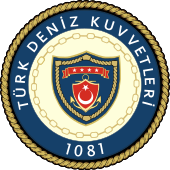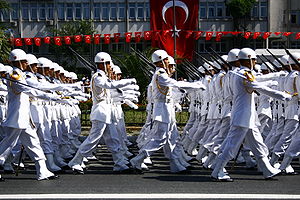Turkish Naval Forces
| Turkish Naval Forces | |
|---|---|
| Türk Deniz Kuvvetleri | |
Seal of the Turkish Navy | |
| Founded | |
| Country | |
| Type | Navy |
| Role | Naval warfare |
| Size | 45,000 personnel[3] |
| Part of | Turkish Armed Forces |
| Headquarters | Ankara |
| Motto(s) | "Always Ready" |
| Colors | Blue, White & Gold |
| March | Turkish Navy March Audio file "Turkish Navy March, December 2013.ogg" not found |
| Anniversaries | September 27[1] |
| Equipment | List of active ships of the Turkish Naval Forces |
| Website | www |
| Commanders | |
| Commander-in-Chief | President Recep Tayyip Erdoğan |
| Minister of National Defence | Hulusi Akar |
| Chief of the General Staff | General Yaşar Güler |
| Commander | Admiral Adnan Özbal |
| Chief of Staff of Turkish Naval Forces | Vice Admiral Aydın Şirin |
| Insignia | |
| Naval Aviation Roundel |  |
| Masthead Pennant | |
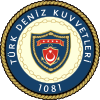 |
| Components |
|---|
| Special Forces |
| Naval infantry |
| History |
| Equipment |
 |
| Leadership |
|---|
| Branches |
| History |
| Special Forces |
| Member of |
| Current overseas deployments and missions |
The Turkish Naval Forces (Turkish: Türk Deniz Kuvvetleri), or Turkish Navy (Turkish: Türk Donanması) is the naval warfare service branch of the Turkish Armed Forces.
The modern naval traditions and customs of the Turkish Navy can be traced back to 10 July 1920, when it was established as the Directorate of Naval Affairs during the Turkish War of Independence led by Mustafa Kemal Atatürk. Since July 1949, the service has been officially known as the Turkish Naval Forces.
In 2008, the Turkish Navy had a reported active personnel strength of 48,600; this figure included an Amphibious Marines Brigade as well as several Special Forces and Commando detachments.[4] As of early 2021, the navy operates a wide variety of ships and 60 maritime aircraft.
History
Ottoman fleet after Mudros
Following the demise of the Ottoman Empire in the aftermath of World War I, on November 3, 1918, the fleet commander of the Ottoman Navy, rear admiral Arif Pasha, ordered all flags to be struck on all warships lying in the Golden Horn, and the Ottoman Navy ceased to exist.[5] The major surface combatants of the former Ottoman fleet (totalling 62,000 tons) were rendered inactive by the Allies and in accordance with the terms of the Armistice of Mudros, the warships were disarmed during the last week of 1918. The battleship Turgut Reis and the cruisers Hamidiye and Mecidiye were substantially limited and kept inactive inside the Golden Horn by the occupying forces.[6] Due to its larger size, the battlecruiser Yavuz Sultan Selim was transferred to the Gulf of Izmit on the grounds that she could adversely affect the sea traffic inside the Golden Horn;[6] while her ammunition and guns were removed.[6] During this period, only a small number of Ottoman Navy vessels were allowed by the Allies to remain on active coast guard duties and were released from internment on 26 February 1919;[5] such as the torpedo boats Akhisar and Dıraç which patrolled the Sea of Marmara, the gunboat Hızır Reis which patrolled the Gulf of İzmir, and the minelayers Nusret and Tir-i Müjgan which conducted mine cleaning operations in the Gulf of Saros.[6]
Before the Turkish War of Independence began, the Bahriye Nazırlığı (Naval Ministry) sent the gunboat Preveze to Sinop and the gunboat Aydın Reis to Trabzon in February 1919 for surveillance, reconnaissance and patrol duties.[6] However, a lack of coal to fuel their propulsion systems caused the Preveze and Aydın Reis to remain in harbour until the end of 1919.[6] During the early stages of the Turkish War of Independence, these two gunboats did not return to Istanbul, despite heavy pressure from the Ottoman government and the Allies.[6] Instead, they were placed under the command of the Turkish liberation forces led by Mustafa Kemal Atatürk and headquartered in Ankara.[6]
Turkish War of Independence
A large number of the naval officers and students of the Naval Academy went to Anatolia for participating in the Turkish War of Independence. On 10 July 1920, the Directorate of Naval Affairs (Umur-u Bahriye Müdürlüğü) was founded in Ankara under the Ministry of National Defense and was given the duty of organizing and maintaining strategic logistical shipping through the Black Sea in order to provide the Turkish liberation forces in Anatolia with weapons and other supplies.[6] All existing naval institutions in the parts of Anatolia that were administered by the Ankara government were assigned to this Directorate.[6] The Directorate of Naval Affairs was extremely successful in organizing local surface units and volunteers and in forming an intelligence network to discover the movements of the enemy ships.[6] As a result, logistic transportation was carried out effectively.[6] The Turkish Grand National Assembly in Ankara made an agreement with the Soviet Union to procure supplies for the Turkish liberation forces.[6] Aydın Reis left from Samsun (on 16 September 1920) and Preveze left from Trabzon (on 30 September 1920) for Novorossiysk in order to transport weapons, other supplies and financial aid to the Turkish liberation forces.[5][6] The Trabzon Shipping Detachment, which was founded on 21 September 1920, was renamed as the Trabzon Naval Shipping Command with the directive issued by the Ministry of National Defense on 26 October 1920.[6] On January 1, 1921, the Samsun Naval Command was formed.[7] In the subsequent stages of the Turkish War of Independence, due to the growing need for maritime shipping and the increase in the quantity and quality of the units and small ships, the organizational structure of the Directorate of Naval Affairs was gradually extended.[6]
In the same period, a number of Turkish civilian seamen formed a group under the name of the Naval Aid Organization (Muavenet-i Bahriye).[7] This group secretly obtained cannons, light weapons, ammunition, landmines and ordnance from the former Ottoman military warehouses in Istanbul that were under the control of the occupying Allies and sent them to the Turkish liberation forces in Anatolia with civil water transportation crafts.[7]
On 1 March 1921, the Directorate of Naval Affairs was transformed into the Presidency of the Naval Department (Bahriye Dairesi Reisliği) and had control over the Naval Commands in Samsun, Amasra and İzmit (formed on 28 June 1921); the Naval Transport Detachment in Trabzon; the Naval Transport Command in Ereğli; the Naval Detachment in Lake Eğirdir; and the Naval Liaison Group in Fethiye (formed on 16 March 1921.)[6] During the War of Independence, Turkish naval forces transported 220,000 tons of weapons, ammunition and equipment to the land forces in Anatolia.[7]
Following the Armistice of Mudanya on 11 October 1922, the former Ottoman Ministry of the Navy (Bahriye Nazırlığı) building in the Kasımpaşa quarter of Istanbul, on the Golden Horn, became the headquarters of the Istanbul Naval Command on 14 November 1922.[6] The establishment of the Ministry of the Navy (Bahriye Vekâleti) of the Republic of Turkey, headquartered in Ankara, was decided by the Grand National Assembly on 29 December 1924, and Topçu İhsan Bey (İhsan Eryavuz) was appointed the first (and only) Naval Minister of Turkey.[8][9] When the Republic of Turkey was established on 29 October 1923, the former Ottoman vessels that remained under Turkish control were as follows:[10]
In active service: 2 cruisers (Hamidiye, Peyk-i Şevket), 2 yachts (Ertuğrul, Söğütlü), 1 destroyer (Taşoz), 4 gunboats (Burak Reis, Hızır Reis, Kemal Reis, İsa Reis), 1 minelayer (Nusret), 1 aviso (Galata), 4 tugs and 7 motorboats. Out of service (needing repair): 2 battleships (Yavuz Sultan Selim, Turgut Reis), 2 cruisers (Berk-i Satvet, Mecidiye), 4 destroyers (Muâvenet-i Millîye, Nümune-i Hamiyet, Basra, Samsun), 6 torpedo boats (Sultanhisar, Yunus, Akhisar, Dıraç, Musul, Berk Efşan), 1 gunboat (Sakız).
Preparations were made to carry out the maintenance and overhaul of small-tonnage warships (the three Taşoz-class destroyers and the gunboats Burak Reis, Sakız, İsa Reis and Kemal Reis) and to make them combat-ready.[6] Thus, the cruiser Hamidiye, which was planned to be employed as a Cadet Training Ship, was overhauled.[6]
During the 1920s, a commitment to refurbish the battlecruiser TCG Yavuz (which remained in active service until 1950) as the centerpiece of the republic's fleet was the only constant element of the various naval policies which were put forward.[11] The battlecruiser remained in İzmit until 1926, in a neglected state:[12][13][14] only two of her boilers worked, she could not steer or steam, and she still had two unrepaired scars from the mine damage in 1918. Enough money was raised to allow the purchase of a new 26,000-metric-ton (26,000-long-ton) floating dock from the German company Flender,[6] as Yavuz could not be towed anywhere without risk of her sinking in rough seas.[15] The French company Atelier et Chantiers de St. Nazaire-Penhöet was contracted in December 1926 to oversee the subsequent refit, which was carried out by the Gölcük Naval Shipyard.[13] Since the Treaty of Lausanne in 1923 required the disarmament of the Turkish Straits, the infrastructures belonging to the Turkish Naval Forces on the Bosphorus (in Istinye) and on the Golden Horn were transferred to Gölcük.[6] In this period, Gölcük was designated as the main Turkish naval base.[6]
The overhaul works of TCG Yavuz proceeded over three years (1927–1930); they were delayed when several compartments of the dock collapsed while being pumped out. Yavuz was slightly damaged before she could be refloated and the dock had to be repaired before the overhaul works could be resumed. The Minister of the Navy, İhsan Eryavuz, was convicted of embezzlement in the resulting investigation which became known as the Yavuz-Havuz case (havuz meaning "dock" in Turkish naval engineering terminology.)[15] The investigation revealed that Ihsan Eryavuz had reduced the insurance obligation of the French company (Atelier et Chantiers de St. Nazaire-Penhöet) from 5 million to 1.5 million Turkish liras, and was convicted guilty of fraud,[16] which resulted in the abolition of the Ministry of the Navy on 27 December 1927.[7][17]
Undersecretariat of the Sea
Following the dissolution of the Ministry of the Navy, the naval forces were reorganized under the Ministry of National Defense[9] and on 16 January 1928[17] the Undersecretariat of the Sea (Deniz Müsteşarlığı) was established in order to undertake the duties of the former Ministry of the Navy.[7] With this new reorganization, the Turkish Fleet Command was put under the command of the Turkish General Staff in terms of administration and logistics.[6] On 2 November 1930, the Naval War College (Deniz Harp Akademisi) commenced training and education of Staff Officers at its facilities in the Yıldız Palace.[6] During World War II, the naval schools were temporarily relocated from Istanbul to Mersin for security reasons and conducted education and training activities in this city.[6]

In 1933, with the approval of the Turkish Grand National Assembly, Gölcük was designated as the main base of the Turkish Navy.[6] In the same year, the first new ship built at the Gölcük Naval Shipyard, the tanker TCG Gölcük, was laid down; and launched the following year.[6] With the signing of the Montreaux Convention in 1936, Turkey's sovereignty over the Turkish Straits was internationally recognized, and Fortified Area Commands were founded on the Bosphorus and Dardanelles straits, with Naval Detachments assigned to these Commands.[6]
The Turkish Naval Forces were represented under the title of the Naval Undersecreteriat at the Turkish General Staff Headquarters in Ankara from 1928 to 1949.[6] The historic decree of the Higher Military Council on 15 August 1949 led to the foundation of the Turkish Naval Forces Command (Deniz Kuvvetleri Komutanlığı.)[6] After Turkey joined NATO on 18 February 1952, the Turkish Naval Forces were integrated into the organizational branches of the alliance.[6]
Structure


In 1961, the Turkish Naval Forces Command was organized into four main subordinate commands: The Turkish Fleet Command, the Turkish Northern Sea Area Command, the Turkish Southern Sea Area Command and the Turkish Naval Training Command.[6] In 1995, the Turkish Naval Training Command was renamed as the Turkish Naval Training and Education Command.[6]
Current Structure
- Fleet Command, Gölcük Naval Base, Kocaeli
- Surface Action Group Command, Gölcük Naval Base, Kocaeli
- Submarine Group Command, Gölcük Naval Base, Kocaeli
- Fast Patrol Boat Group Command, İstanbul
- Mine Warfare Group Command, Erdek Naval Base, Balıkesir
- Logistic Support Group Command, Gölcük Naval Base, Kocaeli
- Naval Aviation Group Command, Cengiz Topel Naval Air Station, Kocaeli
- Gölcük Naval Base Command, Kocaeli
- Gölcük Naval Shipyard Command, Kocaeli
- Inventory Control Center Command, Kocaeli
- Marine Supply Center Command, Kocaeli
- Yıldızlar Surface Training Center, Gölcük, Kocaeli
- Northern Sea Area Command, İstanbul
- Istanbul Strait Command, Anadolukavağı, İstanbul
- Çanakkale Strait Command, Nara, Çanakkale
- Black Sea Area Command, Karadeniz Ereğli, Zonguldak
- Underwater Search and Rescue Group Command, Beykoz, İstanbul
- Rescue Group Command
- Underwater Defence Group Command
- Naval Hydrography and Oceanography Division Command, Çubuklu, İstanbul
- Bartın Naval Base Command, Bartın
- Naval Museum Command, Beşiktaş, İstanbul
- Istanbul Naval Shipyard Command, Pendik
- Southern Sea Area Command, İzmir
- Amphibious Task Group Command, Foça, İzmir
- Amphibious Marine Brigade Command, Foça, İzmir
- Amphibious Ships Command, Foça, İzmir
- Aksaz Naval Base Command, Aksaz Naval Base, Marmaris
- Mediterranean Area Command, Mersin
- İskenderun Naval Base Command, İskenderun, Hatay
- Agean Sea Area Command, İzmir
- Foça Naval Base Command, Foça, İzmir
- Maintenance, Repair and Engineering Command, İzmir
- Amphibious Task Group Command, Foça, İzmir
- Naval Training and Education Command, İstanbul
Marines and Special Forces
The Turkish Navy maintains marine, explosive ordnance disposal and special operations units such as:
- Amphibious Marine Brigade Command – (Turkish: Amfibi Deniz Piyade Tugayı Komutanlığı, AMFİBİ), (Subordinate to Amphibious Task Group Command)
- Underwater Defence Group Command – (Turkish: Sualtı Savunma Grup Komutanlığı, SAS), (Subordinate to Rescue and Underwater Command)
- Underwater Offence Group Command – (Turkish: Sualtı Taarruz Grup Komutanlığı, SAT), (Directly Subordinate to Naval Forces Operations Department)
Equipment
Ships and submarines
As of 2015, the navy operates a wide variety of ships, including; 16 frigates, 9 corvettes, 12 submarines, 18 missile boats, 16 patrol boats, 11 mine countermeasures vessels, 33 landing ships, and various auxiliary ships. In 2021, the total displacement of the Turkish Navy was approximately 267658+ tonnes.[18][failed verification]
Aircraft
The Turkish Navy operates a total of 50+ aircraft, including 15 fixed-wing aircraft and 35 helicopters.


| Aircraft | Origin | Type | Versions | Quantity[20] | Notes |
|---|---|---|---|---|---|
| Fixed-wing aircraft | |||||
| ATR 72 MPA | Maritime Patrol (ASW/ASuW) Transport Aircraft |
72-600 TMPA
72-600 TMUA |
3[21] 2[22] 5[23] |
8 being upgraded by Turkish Aerospace Industries[24][25][26] | |
| CASA CN-235 | Maritime Patrol (ASW/ASuW) | CN-235-100M | 6[22] | License-built by TAI Electronic systems upgraded by Thales[27][28] | |
| SOCATA TB family | Trainer Aircraft | TB-20 | 4[29] | ||
| Helicopters | |||||
| Sikorsky S-70B-28 Seahawk | Maritime Helicopter (ASW/ASuW) | S-70B-28 | 24[30] | ||
| Agusta-Bell AB-212 ASW | Maritime Helicopter (ASW) | Anti-Submarine Warfare
Utility |
13[31] | ||
| AH-1 SuperCobra | Attack helicopter | AH-1W | 10 | Helicopters operated by the Turkish Army will be transferred to the Navy to be stationed on TCG Anadolu.[32] | |
| Unmanned aircraft vehicles | |||||
| TAI Anka[33][34][35] | UCAV | Anka-B with SAR | 8[36] | Equipped with an automatic identification system and synthetic aperture radar (SAR) | |
| Bayraktar TB2[37][38][39] | UCAV | TCB TB-2 | 10[40] | ||
| TAI Aksungur[41][42] | UCAV | 3[43] | Equipped with Satcom | ||
Insignia
| NATO code | OF-10 | OF-9 | OF-8 | OF-7 | OF-6 | OF-5 | OF-4 | OF-3 | OF-2 | OF-1 | OF(D) | Student officer | ||||||||||||||||||||||||
|---|---|---|---|---|---|---|---|---|---|---|---|---|---|---|---|---|---|---|---|---|---|---|---|---|---|---|---|---|---|---|---|---|---|---|---|---|
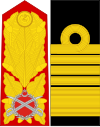
|

|

|

|
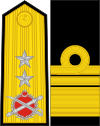
|

|

|

|

|

|

|

|

|
Various [a] | |||||||||||||||||||||||
| Büyük amiral | Genelkurmay başkanlığı | Oramiral | Koramiral | Tümamiral | Tuğamiral | Albay | Yarbay | Binbaşı | Yüzbaşı | Üsteğmen | Teğmen | Asteğmen | Bahriyeli | |||||||||||||||||||||||
| NATO code | OR-9 | OR-8 | OR-7 | OR-6 | OR-5 | OR-4 | OR-3 | OR-2 | OR-1 | |||||||||||||||||||||||||||
|---|---|---|---|---|---|---|---|---|---|---|---|---|---|---|---|---|---|---|---|---|---|---|---|---|---|---|---|---|---|---|---|---|---|---|---|---|

|

|

|

|

|

|

|

|

|

|

|
No insignia | |||||||||||||||||||||||||
| Astsubay kıdemli başçavuş | Astsubay başçavuş | Astsubay kıdemli üstçavuş | Astsubay üstçavuş | Astsubay kıdemli çavuş | Astsubay çavuş | Astsubay astçavuş | Uzman çavuş | Çavuş | Uzman onbaşı | Onbaşı | Er | |||||||||||||||||||||||||
- Non-Turkish speakers might like to know that OF3, OF2, and OR2 literally translates as "Head of 1000", "Head of 100", and "Head of 10", respectively.
The Turkish Navy is currently undergoing several modernisation programmes to replace its ageing equipment. Currently MILGEM project is the largest project of the Navy. As of 2022, the major modernisation projects are as follows:
Ships & Submarines
Multi-purpose amphibious assault ship (LHD) project

TCG Anadolu (L-400) amphibious assault ship / aircraft carrier is scheduled to enter service by 2021.[45] The construction of a sister ship, to be named TCG Trakya, is currently being planned by the Turkish Navy [46][47]
TCG Anadolu, which will be the flagship when delivered to the Turkish Naval Forces, will also be the largest war platform in the history of the Turkish Navy.[45] The amphibious assault ship is expected to host a fleet of Bayraktar TB3 unmanned aerial vehicles.[48][49]
Bayraktar-class tank landing ship
Two of the ships developed for the modern tank landing (LST) vessel requirement of the Turkish Navy successfully serve the Turkish Naval Forces. Bayraktar-class ships, largest LST ships in the world. Planned to deliver 2 Bayraktar class LST ships to the Turkish Naval Forces in 2023-2024.
The ships have a large interior, the hospital, the fore and aft heavy load ramps, the ramp that provides access to the upper deck, the capacity of carrying 400 amphibious personnel, the ability to drop and collect mines, 4 LCVP extraction vehicles that can move from the ship.[50]
TF-2000-class air defense destroyer
It is known that 15 ships of three types will be built within the scope of the National Ship (MILGEM) project, which aims to meet the warship needs of the Turkish Navy through national means: Corvette (Ada Class), Frigate (I Class) and Destroyer (TF-2000 Class). First four ships to be built within this scope, TCG Heybeliada (F-511), TCG Büyükada (F-512), TCG Burgazada (F-513) and TCG Kınalıada(F-514) Corvettes, were delivered to the Naval Forces Command.
With the MİLGEM project launched under the leadership of the Naval Forces, the goal of our country's first national combat ship has been achieved. The design activities of the TF-2000 Air Defence Warfare (ADW) Destroyer Project, the last phase of the MILGEM Project, started by the Design Project Office (DPO) in 2017. It was decided to produce 7 of the TF-2000 Destroyers, which were planned to be produced 4 in the beginning, considering the increasing threats in the region and the date when the ships will enter the inventory. The first ship is planned to be delivered to navy in 2027.[51]
Istanbul-class frigate

The I-class Frigate Program was launched to construct four frigates to replace aging Yavuz-class Frigates in mid 2020s. Developed under the MILGEM indigenous warship program, the Istanbul-class is an enlarged variant of the Ada-class anti-submarine corvette. The I-class Frigates will have around 50% increased fuel capacity and operational/sailing range capability compared to Ada-class corvettes.[52]
First Istanbul class frigate TCG İstanbul [tr] was launched on 23 January 2021.[53][54][55] It is expected that the acceptance tests will be completed in January 2023 and the ship will be delivered in September 2023.[56]
Barbaros-class frigate modernization

With the Barbaros Class Frigate Half-Life Modernization Project, which has been going on for a long time, it is aimed to remove the existing combat systems of 4 Barbaros Class Frigates registered in the inventory of the Naval Forces Command, and to equip them with systems developed locally and nationally by ASELSAN - Havelsan Business Partnership in accordance with the requirements of the era.
It is planned that the modernization of the first ship to be equipped with domestic systems will be completed in February 2022 and the ship will be put into service.[57]
Reis-class submarine
The Type 214 class vessels are regarded as a first for the Turkish Navy due to its air-independent propulsion technology made possible by fuel cell technology. The vessels also can deploy heavyweight torpedoes and anti-ship missiles and lay mines against targets, both at sea and on the ground, Turkish media reported. Apart from Piri Reis, five more vessels of the project are expected to hit the seas by 2027. As Piri Reis was deployed to the sea, the project's second submarine Hızırreis’ outfitting and two vessels’ hull production phases are ongoing. In 2015, Golcuk Naval Shipyard commenced a 10 year programme to build 6 Type 214, locally known as Reis class submarines with technology from Thyssenkrupp Marine Systems of Germany.[58]
Preveze-class submarine modernization
Half-life Modernisation Project of Preveze Class Submarines covers the modernisation of TCG Preveze (S-353), TCG Sakarya (S-354), TCG 18 Mart (S-355) and TCG Anafartalar (S-356) submarines in the inventory of the Naval Forces Command. Modernisation activities are carried out by STM-ASELSAN-HAVELSAN and ASFAT Partnership.
In the modernisation process, it is planned to carry out the procurement activities of Inertial Navigation System, Salinity-Depth-Density Measurement System, Floating Antenna, Satellite Communication Mast, Assault and Navigation Periscope System, Emergency Underwater Communication System, Cooled Water System, Static Converter and Air Freshening System by STM.[59]
ULAQ Armed Unmanned Surface Vehicle
ULAQ is the first indigenous and locally developed Armed Unmanned Surface Vehicle (AUSV). The vehicle is being developed by a joint venture between Ares Shipyard and METEKSAN. The vessel is planned to be equipped with four Cirit and two L-UMTAS anti-tank missile systems provided by Roketsan. Moreover, ULAQ is projected to have a 400-kilometer-long cruising range with 65 km per hour maximum speed. The vessel is planned to be operated in missions such as reconnaissance, surveillance and intelligence, surface warfare, asymmetric warfare, armed escort and force protection, and strategic facility security.[60] Currently, the project is undergoing sea trials and will start to fire tests through the third quarter of 2021.[61][62] First firing test of the vessel was completed on 26 May 2027 by destroying a designated target with Roketsan Cirit Missile.[63]
Bayraktar TB3
In February 2021, chairman of the Presidency of Defense Industries (SSB) Ismail Demir made public a new type of UAV being developed by Baykar that is planned to be stationed to Turkey's first amphibious assault ship, TCG Anadolu.[64] The new aircraft being developed is a naval version of the Bayraktar TB2 equipped with a local engine developed by TEI.[65] According to the initial plans the ship was expected to be equipped with F-35B fighter jets but following the removal of Turkey from the procurement program, the vessel got into a modification process to be able to accommodate UAVs. Mr. Demir stated that between 30 and 50 folding-winged Bayraktar TB3 UAVs will be able to land and take off using the deck of Anadolu.[66][67]
See also
- Turkish Armed Forces
- Turkish Land Forces
- Turkish Air Force
- Lists of ships of the Turkish Navy
- Ottoman Navy
- List of Commanders of the Turkish Naval Forces
Notes
- ^ Student officer insignia designates school grade rather than military seniority.
References
- ^ a b History of Turkish Naval Forces (Official Turkish Naval Forces website)
- ^ 1949 Temmuzunda Türk Silâhlı Kuvvetleri yeniden örgütlendirilerek, Genelkurmay Başkanlığına bağlı Kara, Deniz, Hava Kuvvetleri kuruldu., Genelkurmay Başkanlığı, Türk Tarihi, Silahlı Kuvvetleri ve Atatürkçülük, Genelkurmay Başkanlığı, 1973, p. 65. (in Turkish)
- ^ The Military Balance 2020 (2020 ed.). London: The International Institute for Strategic Studies. 14 February 2020. pp. 153–156. ISBN 9780367466398.
- ^ Library of Congress - Federal Research Division (August 2008), Country Profile: Turkey (PDF), pp. 25–26
- ^ a b c d e f g h i j k l m n o p q r s t u v w x y z aa ab ac ad ae af ag ah "Hata Sayfası". Retrieved 14 December 2014.
- ^ a b c d e f Cevat Ülkekul, "Kurtuluş Savaşı'nda Türk Denizcileri ve Cumhuriyet Bahriyesinin Kuruluşu" ("Turkish Seamen during the War of Independence and Establishment of the Republican Navy"), Uluslararası Piri Reis Sempozyumu, 27-29 Eylül 2004 (Bildiri), Office of Navigation of Hydrography and Oceanography. (in Turkish)
- ^ Ümit Özdağ, Atatürk ve İnönü dönemlerinde Ordu-Siyaset İlişkisi, Bilgeoğuz, 2006, p. 97. (in Turkish)
- ^ a b Türkiye Diyanet Vakfı İslâm ansiklopedisi, Vol 12, Türkiye Diyanet Vakfı, İslâm Ansiklopedisi Genel Müdürlüğü, 1988,[page needed] (in Turkish)
- ^ Güvenç and Barlas, p. 7
- ^ Gardiner and Gray, p. 391
- ^ a b Whitley, p. 241
- ^ Worth, p. 271
- ^ a b Brice, p. 277
- ^ "The Yavuz-Havuz Case (Turkish)". Retrieved 27 October 2015.
- ^ a b Genel Tarihçe, Turkish Navy official site.
- ^ Cem Devrim Yaylalı. "Bosphorus Naval News". turkishnavy.net. Retrieved 13 June 2021.
- ^ Deniz-Web.com. "TUSAŞ'ın ürettiği menzili artırılmış 2 ANKA SİHA Deniz Kuvvetleri Komutanlığına teslim edildi || GLOBAL SAVUNMA - Strateji - Güvenlik - Savaş Teknolojileri - İstihbarat". www.globalsavunma.com.tr. Retrieved 26 March 2021.
- ^ "About the FlightGlobal Group - AirSpace Announcement". Flightglobal.com.
- ^ "MELTEM-III Projesi'nde kabul faaliyetleri başladı | SavunmaSanayiST" (in Turkish). 8 October 2020. Retrieved 29 August 2022.
- ^ a b "Türk Deniz Kuvvetleri Komutanlığı". www.dzkk.tsk.tr. Retrieved 19 August 2020.
- ^ "Deniz Kuvvetleri'ne P-72 Deniz Karakol Uçağı Teslimatı" (in Turkish). 21 October 2022. Retrieved 22 October 2022.
- ^ Turkish Aerospace Industries, Inc. "MELTEM III (ATR-72)". Turkish Aerospace Industries, Inc. Retrieved 14 December 2014.
- ^ "Alenia Aermacchi Delivers First ATR72-600 TMUA to Turkish Navy". 24 July 2013.
- ^ "Raytheon to provide torpedo integration for Turkish Navy ATR-72-600ASW maritime patrol aircraft". 17 July 2014.
- ^ Turkish Aerospace Industries, Inc. "MELTEM II (CN-235)". Turkish Aerospace Industries, Inc. Archived from the original on 10 December 2014. Retrieved 14 December 2014.
- ^ "Thales finalises delivery of MELTEM II CASA CN-235 maritime patrol aircraft to Turkey". 28 April 2014.
- ^ "Deniz Kuvvetleri Komutanlığı • TB-20 Eğitim". 24 January 2021. Archived from the original on 24 January 2021. Retrieved 29 August 2022.
- ^ "Türk Deniz Kuvvetleri Komutanlığı". www.dzkk.tsk.tr. Retrieved 19 August 2020.
- ^ Embraer, In association with. "World Air Forces directory 2022". Flight Global. Retrieved 22 October 2022.
- ^ "Türk Deniz Kuvvetleri'ne 10 adet AH-1W Super Cobra" (in Turkish). 16 November 2021. Retrieved 2 February 2022.
- ^ "Turkey Delivers Upgraded ANKA Combat Drone to Navy". www.defenseworld.net. Retrieved 26 March 2021.
- ^ "PDF TAI ANKA & BAYRAKTAR TB2 NAVY" (PDF).
- ^ "ANKA turkish naval forces official site".
- ^ Ozberk, Tayfun (6 August 2022). "Turkish Navy acquires 3rd Aksungur MALE UCAV". Naval News. Retrieved 29 August 2022.
- ^ "Deniz Kuvvetleri Komutanı TB2'yi üreten Baykar Savunma yönetimi ile bir araya geldi". Droneturk ® (in Turkish). 28 January 2021. Retrieved 26 March 2021.
- ^ QuarkPlayer, player-inline {display: inline-block;padding-bottom: 56 25%;position: relative;width: 100%;z-index: 5;} player-box {height: 100%;left: 0;position: absolute;top: 0;width: 100%;}$ ready{quarkPlayer = new; bufferLength:5; true, autoPlay; false, subTitles; true, showAds; false, showNotification; showB; true, widthSelector; false, customMenu. "Deniz Kuvvetleri Komutanlığı'na teslim edilen SİHA ilk test uçuşunu yaptı". Milliyet (in Turkish). Retrieved 26 March 2021.
- ^ "Deniz Kuvvetleri'ne Bayraktar TB-2 teslimatı | SavunmaSanayiST" (in Turkish). 4 April 2019. Retrieved 26 March 2021.
- ^ Mehmet, Fatih (26 April 2018). "Deniz Kuvvetleri'nde ANKA ve Bayraktar TB2 dönemi".
- ^ SABAH, DAILY (20 October 2021). "Turkish navy receives first Aksungur UAV". Daily Sabah. Retrieved 21 October 2021.
- ^ "Turkish Navy receives the first domestically produced Aksungur UAV - Shephard Media". www.shephardmedia.com. Retrieved 21 October 2021.
- ^ Ozberk, Tayfun (6 August 2022). "Turkish Navy acquires 3rd Aksungur MALE UCAV". Naval News. Retrieved 29 August 2022.
- ^ a b Alemdar, Ahmet (11 January 2021). "TCG ANADOLU 2021 yılında Türk Deniz Kuvvetlerine teslim ediliyor".
- ^ Ahmet Doğan (9 November 2019). "TCG Trakya ne zaman bitecek?". DenizHaber.com.
- ^ Anıl Şahin (14 February 2019). "Deniz Kuvvetlerinden TCG Trakya açıklaması". SavunmaSanayiST.com.
- ^ "Turkey unveils new image of the future TCG Anadolu with a drone". Navy Recognition. Retrieved 7 June 2021.
- ^ "PREMIUM: Will TB3 help Anadolu recover from F-35 fiasco? - Naval Warfare - Shephard Media". www.shephardmedia.com. Retrieved 7 June 2021.
- ^ "Bayraktar Sınıfı Tank Çıkarma Gemileri". 16 April 2020.
- ^ "TF-2000 Air Defence Warfare (ADW) Destroyer | Turkish Defence News".
- ^ "Turkey launches the lead ship of I-class frigates "Istanbul"". 23 January 2021.
{{cite web}}:|first=missing|last=(help) - ^ Yıldırım, Göksel (17 January 2021). "Milli fırkateyn 'İstanbul' denize indiriliyor". aa.com.tr (in Turkish). Anadolu Agency.
- ^ "Cumhurbaşkanı Erdoğan: Kendi savaş gemisini tasarlayan 10 ülke içinde yer alıyoruz". aa.com.tr (in Turkish). Anadolu Agency. 23 January 2021.
- ^ "MİLGEM Projesi'nin 5'inci gemisi İstanbul (F-515) Fırkateyni'nin denize iniş töreni". aa.com.tr (in Turkish). Anadolu Agency. 23 January 2021.
- ^ Alemdar, Ahmet (2 January 2021). "İlk İ sınıfı fırkateyn TCG İSTANBUL 17 Ocak'ta denize indiriliyor" (in Turkish).
- ^ Mehmet, Fatih (3 January 2021). "Barbaros Sınıfı Fırkateyn Yarı Ömür Modernizasyonu Projesi Üzerine Notlar".
- ^ "Turkey Launches Submarine with Air-independent Propulsion". www.defenseworld.net.
- ^ "STM - Turkish Navy Type 209-1400 PREVEZE Class Submarine". STM.
- ^ "Meteksan unveils a new version of ULAQ vessel". www.navyrecognition.com. 3 May 2021. Retrieved 11 May 2021.
- ^ SABAH, DAILY (12 February 2021). "Turkey's 1st unmanned marine craft begins trial trips". Daily Sabah. Retrieved 11 May 2021.
- ^ "Turkey launches its first armed unmanned marine vehicle prototype". Turkey launches its first armed unmanned marine vehicle prototype. Retrieved 11 May 2021.
- ^ "Armed Unmanned Marine Vehicle ULAQ Accurately Hit". RayHaber | RaillyNews. 27 May 2021. Retrieved 27 May 2021.
- ^ SABAH, DAILY (25 March 2021). "Turkey's TCG Anadolu to allow drones to land, takeoff in global 1st". Daily Sabah. Retrieved 11 May 2021.
- ^ AA, DAILY SABAH WITH (30 October 2020). "Local engines to power Turkey's cutting-edge combat drones". Daily Sabah. Retrieved 11 May 2021.
- ^ Ozberk, Tayfun (29 April 2021). "Turkey plans to deploy attack drones from its amphibious assault ship". Defense News. Retrieved 11 May 2021.
- ^ Axe, David. "Behold The Turkish Navy's Drone Aircraft Carrier". Forbes. Retrieved 11 May 2021.
External links
- Articles with Turkish-language sources (tr)
- Justapedia articles needing page number citations from December 2010
- Articles with invalid date parameter in template
- CS1 Turkish-language sources (tr)
- CS1 errors: missing name
- Articles with short description
- Short description with empty Wikidata description
- Use dmy dates from June 2021
- Articles containing Turkish-language text
- Pages linking to missing files
- All articles with failed verification
- Articles with failed verification from June 2021
- Articles with missing files
- Commons category link is locally defined
- Turkish Naval Forces
- Military units and formations established in 1920
